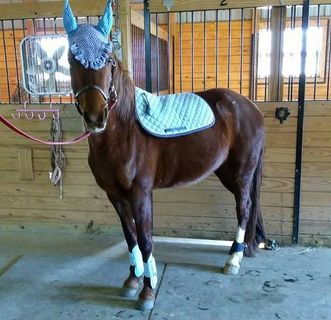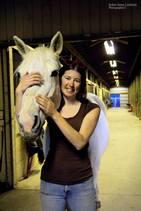|
Consider treats payment to your horse for a job well done! Riding is after all our idea! When the temps are mild and the sky is clear there is an abundance of activities you can do with your equine partner. For many horse owners spending time at the barn is cathartic, but what about when the ground is frozen or too muddy to ride, the temperature and air quality soar into unsafe levels or the weather just won't cooperate? Even with an indoor riding arena horses and humans can get ring sour. There are still fun ways to interact with your horse that don't include riding in circles! Give your horse a massage and muscle shake out!Standing in a stall (or in a run in shed to stay out of the weather) can cause your horse to get stiff and sore. To start, check your horse for soreness with gentle palpation along the back. With your fingers four inches down from the spine, apply pressure on each side of the withers and run your fingers the full length of the spine. If your horse dips or moves away from the pressure that's an indication of soreness. Apply gentle pressure and rubbing to the muscles in the area, careful not to put direct pressure on the spine. To loosen muscles in your horse haunches and shoulders, begin by lifting each leg one at a time. Hold the hoof from the toe low enough that there isn't pressure on the joints, but off the ground so that the horse doesn't lose their balance. With the other hand, gently shake the horses knee or hock side to side till your horse relaxes their upper muscles. Stretching keeps them limber!To further spoil and relax your horse, add some stretches! A great series to teach your horse which is great fun for them (treats!) and can be used later as a foundation for trick training are the Carrot Stretches. Ask your horse to keep their feet still and reach their neck and head around to reach a treat or clicker point back by their haunches. Most horses can't reach all the way to their tail at first, so reward your horse for a stretch that is as far as they are willing to go without assistance. Never pull your horses head further than they are willing to move it! After stretching towards their haunches on either side ask them to reach for a point down towards their hock. Lastly, hold a treat directly below the horses nose and over time move this treat between their legs and towards their belly. Be sure to do each stretch on both sides and reward your horse for effort. Cleaning and checking the fit of your tack plus looking for weak points is another great rainy day activity! Yielding the HaunchesIf your horse needs some exercise and mental stimulation, teach them to yield their haunches. In a herd the horse who is dominant is the one who can cause the other horses to move their feet. While teaching a horse to move their yield their haunches can be used to establish a working relationship with your horse, it's also a great stretch over their back. With a halter and long lead rope on your horse stand facing the side of your horse about halfway down their body. With the handle of a whip or even your fingers, start by pointing at your horses haunches and step towards them. If your horse doesn't move their rear end away from you help them understand by drawing their head towards you with the lead rope. You may have to start out by tapping your horse with the handle of the whip or poking them with your fingers while drawing their head towards you at first. Each time your horse yields away from you stop and reward them with strokes on the neck and kind words. Over time you will find that your horse will move away from a simple look and step toward their haunches!
2 Comments
|
About the blogFerrets and Friends, LLC has four writers bringing you information on a variety of topics from pets to wildlife, education to conservation, and from new developments in our business to information about our industry. Learn something new each week! Archives
August 2020
Categories
All
|



 RSS Feed
RSS Feed